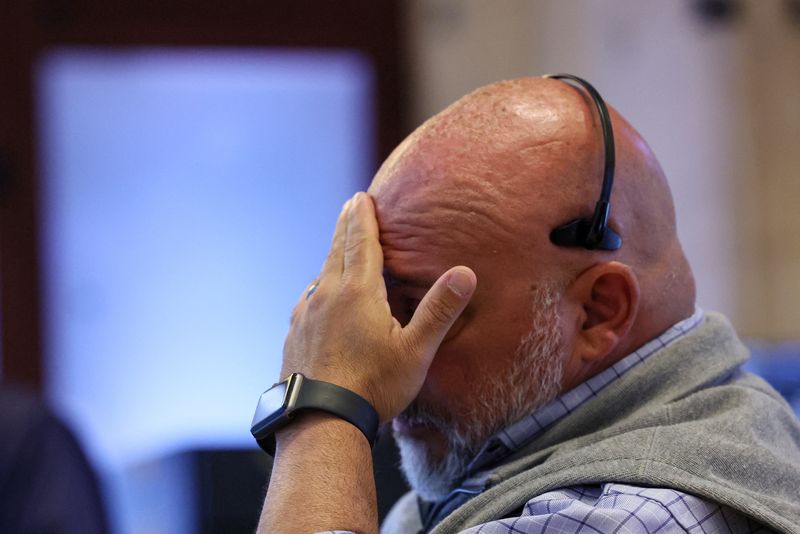By Sinéad Carew and Nell Mackenzie
NEW YORK/LONDON (Reuters) – Stocks suffered heavy losses around the world on Monday as Wall Street added momentum to the rout that started in Japan, while the dollar tumbled against the yen and nervous investors looked for signs of a recession in the United States.
However, U.S. Treasury yields recovered as solid activity in the U.S. services sector eased recession fears after falling to their lowest levels in more than a year earlier Monday. Chicago Federal Reserve President Austan Goolsbee boosted sentiment when he said Friday’s weak jobs report did not indicate a recession.
Still, oil prices edged lower on Monday as recession fears led to demand concerns, but the declines were buffered by concerns that an escalating conflict in the Middle East could dent crude supplies.
Earlier, Japan’s benchmark average had fallen 12.40%, marking the biggest one-day decline since October 1987, as the yen rose against the backdrop of last week’s Japanese decision to raise interest rates to levels not seen in 15 years. were.
The yen rose sharply against the dollar on Monday due to the aggressive unwinding of so-called carry trades, in which investors borrow money from economies with low interest rates such as Japan to finance investments in higher-yielding assets elsewhere.
“The fact that the dollar/yen fell so much in turn forced investors to take some profits where they were hiding this year, which was mainly big tech,” said Kevin Gordon, senior investment strategist at Schwab.
“It has become the biggest target because it had the best performance and that is probably the easiest place for traders to take their profits.”
A weaker-than-expected U.S. payrolls report for July signaled the start of a sell-off on Wall Street on Friday, as investors’ bets on a Federal Reserve rate cut in September suddenly doubled to 50 basis points. The jobs figures followed disappointing earnings updates from some US mega-cap tech companies.
However, US stock prices pared some of the losses after the Institute for Supply Management (ISM) said on Monday that service sector activity recovered from a four-year low in July, with orders and employment rising, easing recession fears .
The purchasing managers’ index (PMI) for the non-manufacturing sector rose to 51.4 from 48.8 in June, higher than economists’ expectations of 51.0. A PMI value above 50 indicates growth in the services sector, which accounts for more than two-thirds of the US economy.
On Wall Street, shares fell 1,033.99 points, or 2.60%, to 38,703.27, lost 160.23 points, or 3.00%, to 5,186.33 and lost 576.08 points, or 3 .43%, to 16,200.08.
The MSCI index of shares around the world fell 25.58 points, or 3.25%, to 761.63, the biggest one-day percentage drop since September 2022. The European index previously fell 2.17 %.
And CBOE’s volatility index, known as Wall Street’s fear gauge, recorded its biggest intraday jump before ending the day at 38.57 points, which was its highest close since October 2020.
In currencies, the Japanese yen rose to a seven-month high against the dollar as traders interpreted last week’s U.S. economic data as an improvement in the outlook for a U.S. recession and steeper than previously expected Fed rate cuts.
The , which measures the dollar against a basket of currencies including the yen and euro, fell 0.46% to 102.68.
Against the Japanese yen, the dollar weakened 1.77% to 143.94, while the euro rose 0.45% to $1.0957.
On US government bonds, James Knightley, chief US economist at ING, said services sector data on Monday was a key factor in yield recovery, along with Goolsbee’s comments.
Knightly said Goolsbee is “notably the most moderate member at the Fed in quite some time and he wasn’t suggesting there was any real alarm.”
The yield on U.S. 10-year benchmark bonds fell 1.1 basis points to 3.785% from 3.796% late on Friday, while the yield on 30-year bonds fell 3.5 basis points to 4.0763%.
The yield, which typically tracks with interest rate expectations, rose 3 basis points to 3.9017%, up from 3.872% late on Friday.
The market’s risk aversion was also reflected in tighter spreads on US interest rate swaps, Secured Overnight Financing Rate (SOFR) futures and the Federal Funds Rate, along with rising spreads on US junk bonds.

In energy markets, they fell 0.79% to $72.94 per barrel and ended at $76.30 per barrel, down 0.66% on the day.
In terms of precious metals, gold seemed to lose some of its safe-haven appeal. lost 1.52% to $2,406.16 an ounce. The US fell 0.74% to $2,407.70 an ounce.


